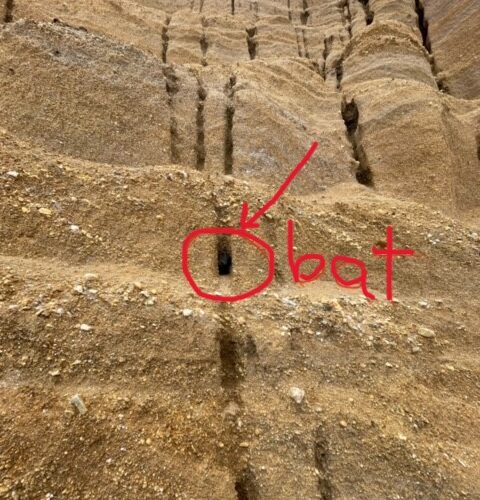Naturalists searching for fossils and beachcombing around the eroding cliffs at Lucy Vincent Beach on October 13th were rewarded with a different prize: a silver-haired bat sleeping in a crevice! Two iNaturalist users, ssmyers (Scott Smyers) and kkarbe (Kylee Karbe), documented this bat nearly simultaneously as it was roosting in the cliffs on October 13th. Kylee’s sharp-eyed 11-year-old daughter, Saskia, spotted the bat first.
This incredible find is a great way to mark Bat Week (October 24 – 31), an annual celebration of the amazing and adaptable bats that share this planet with us. This silver-haired bat (Lasionycterus noctivagans) observation illustrates the resourcefulness of these mammals. While many bat species hibernate to survive the cold winter months when few insects are available, silver-haired and other tree-roosting bat species migrate south. They stop and rest along the way, and silver-haired bats typically roost alone during migration. They can be found in all sorts of natural roosting habitats including: tree cavities, behind loose bark on trees, rocky outcroppings, and, clearly, crevices in cliffs. Over the past few years we have even had reports of silver-haired bats found in wood piles on the island. Since our winters are fairly mild, a few migrating bats can be found even into December and January (for example, see this blog post from December 2023).
How did this bat find this unusual roost? We think it was likely feeding along the south shore of the island as dawn approached and noticed a crevice on the cliffs that offered a safe and secure spot to sleep for the day. That evening, this bat likely awoke and continued feeding along the south shore. Its next movement would either be due west across the open water to the mainland or perhaps a longer open water movement to the southwest. We can’t be sure because very little is known about the migratory movements of bats in the ocean environment.
Silver-haired bats, eastern red bats, and hoary bats are all long distance migrants, but most of what we know about their migration is from studies over land. Many of these bats have died from collisions with land-based wind turbines during migration, and their populations are declining. They are all Species of Special Concern in Massachusetts. Curtailment (stopping wind turbines during peak bat migration periods) is helping reduce bat mortality at land-based turbines, and a lot of research is focused on new equipment to detect bats near turbines to inform curtailment. Migratory tree bats could also be vulnerable to off-shore turbines, but research is needed to determine their collision risks. BiodiversityWorks has been busy applying for grant funds that will allow us to study the migratory movements of these bat species over the ocean and assess their vulnerability to current and future wind development. Observations like this one help us by providing valuable data on when are where bats are feeding and resting. Thank you to Scott and Kylee for posting to iNaturalist!
Liz Olson is the Assistant Director of BiodiversityWorks and has coordinated many years of research on bats on Martha’s Vineyard.


